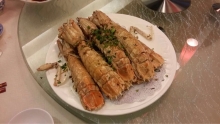Apicius and the Foundations of an Italian Gastronomic Culture
Italy may be home to the world’s oldest known cookbook.
This suggests the potential for unifying characteristics within such diversity. Sometimes attributed to the famous epicure Marcus Gavius Apicius of the first century A.D., the cookbook De re coquinaria (On Cookery) is a collection of hundreds of ancient Roman procedures for preparing dishes. The collection was not so much recipes in the modern sense as they were basic directions for the preparation of ingredients intended for the experienced chef. Apicius, a name generally associated with the love for food, likely accounts for the majority of the cookbook, though the damaged manuscripts preserved from a later century are actually a collection of recipes from numerous sources assembled sometime in the fourth or fifth century A.D. (Internet Source). Other ancient Roman writers--including Cato, Pliny, and Horace--identified early place names and their famous goods, from the wild boar of Tuscany and the onions of Pompeii to the cultivated asparagus of Ravenna and the semolina wheat of Campania (Capatti and Montanari 2003). The lists are extensive and are a clear antecedent of famous regional products that define regions within Italy and are available at specialty import markets internationally today.
Italy may be home to the world’s oldest known cookbook.
This suggests the potential for unifying characteristics within such diversity. Sometimes attributed to the famous epicure Marcus Gavius Apicius of the first century A.D., the cookbook De re coquinaria (On Cookery) is a collection of hundreds of ancient Roman procedures for preparing dishes. The collection was not so much recipes in the modern sense as they were basic directions for the preparation of ingredients intended for the experienced chef. Apicius, a name generally associated with the love for food, likely accounts for the majority of the cookbook, though the damaged manuscripts preserved from a later century are actually a collection of recipes from numerous sources assembled sometime in the fourth or fifth century A.D. (Internet Source). Other ancient Roman writers--including Cato, Pliny, and Horace--identified early place names and their famous goods, from the wild boar of Tuscany and the onions of Pompeii to the cultivated asparagus of Ravenna and the semolina wheat of Campania (Capatti and Montanari 2003). The lists are extensive and are a clear antecedent of famous regional products that define regions within Italy and are available at specialty import markets internationally today.












0 Comment
Comment